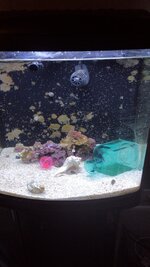4 years ago I had researched the care and keeping of Octopuses (specifically the bimac) and prepped a 54 gallon corner tank. After months of waiting for a bimac, I realized I wouldn't be able to get one and settled for the only available non-dwarf species, the exotic wonderpus. I thought it would all be the same, I had 3 chromis which helped cycle the tank, a variety of snails and hermits and a separate tank housing red claw crabs for feeding. I will be brief here because this is just back story but she died within 2 weeks after suffering from autophagy (sp?). This isn't such a surprise as she was a wonderpus and I had no business keeping one.
I have recently obtained a brown Pacific dwarf species (that is literally the only information I have from Sea Dwelling Creatures). She is living in a 24g nanocube that has cycled for at least 3 months. I'll admit that there is very little rock right now, having settled on a supposedly easy but nocturnal species, I at least wanted to see her. It has been 4 weeks and I do sometimes see her at night but once again I'm seeing the limp curl on one arm and the tips of some of the others look bitten off. For food I have been trying to feed frozen baby krill (it's about the size of a very large fish turd), frozen mysis, 2 blue legged hermits and there are several species of snail crawling the tank (margarita, cerith, astrea). So far I've seen margarita snails go missing and some cerith snails and I think a piece of krill was eaten but I can't confirm. She (I have no idea if she is female) pounced on it and changed colors like she was ingesting. She also has a medium size conch shell and huge turbo shell to hide in and she is about the size of my thumb digit.
I have added a Silicone Tea Strainer with small pieces of imitation crab and a plastic cat ball with a plastic bell but she didn't appear interested in either.
I will upload more info (water params + pictures tonight) but last I checked, nitrates were 20 and no presence of ammonia or nitrites and temp 78.
I have recently obtained a brown Pacific dwarf species (that is literally the only information I have from Sea Dwelling Creatures). She is living in a 24g nanocube that has cycled for at least 3 months. I'll admit that there is very little rock right now, having settled on a supposedly easy but nocturnal species, I at least wanted to see her. It has been 4 weeks and I do sometimes see her at night but once again I'm seeing the limp curl on one arm and the tips of some of the others look bitten off. For food I have been trying to feed frozen baby krill (it's about the size of a very large fish turd), frozen mysis, 2 blue legged hermits and there are several species of snail crawling the tank (margarita, cerith, astrea). So far I've seen margarita snails go missing and some cerith snails and I think a piece of krill was eaten but I can't confirm. She (I have no idea if she is female) pounced on it and changed colors like she was ingesting. She also has a medium size conch shell and huge turbo shell to hide in and she is about the size of my thumb digit.
I have added a Silicone Tea Strainer with small pieces of imitation crab and a plastic cat ball with a plastic bell but she didn't appear interested in either.
I will upload more info (water params + pictures tonight) but last I checked, nitrates were 20 and no presence of ammonia or nitrites and temp 78.

